Nokia Lumia 735 Review
by Brett Howse on February 3, 2015 6:00 AM EST- Posted in
- Smartphones
- Microsoft
- Nokia
- Lumia
Display
Smartphone displays are one of the most important features of any device. It is the prime method of interaction, it provides information, and for a lot of people, it is their window into the world. We put a lot of testing into displays because of their importance. The Lumia brand contains both Liquid Crystal Displays (LCD) and Organic Light Emitting Diode (OLED) panels depending on the model, and in the case of the Lumia 735 it has a 1280x720 resolution OLED in an RGBG format. While not as high resolution as many flagships today, the 4.7 inch display still packs in 316 pixels per inch, so based on that number alone it should be fairly sharp.
Lumia displays often pack in extra features as well, and the Lumia 735 is no exception. The protective outer shell is Corning Gorilla Glass 3, which has an “Easy to Clean” coating on top. The lower end Lumia phones lack this coating, and it can give them a surface with too much grip, making it difficult to move your finger around smoothly. Thankfully the Lumia 735 has no such issues. Nokia added ClearBlack to most of their models, and the Lumia 735 does have this polarizer to help with outdoor visibility and improve black levels. Another feature of many Lumia phones is the Super Sensitive Touch which allows the display to be used with gloves on – a boon when you live in colder climates or on Hoth. It also features the same Sunlight Readability Enhancements as other Lumia models such as the 930, which is content-adaptive backlight control software called Assertive Display from Apical. This makes the screen much easier to use outdoors, as this image from our Lumia 930 review shows.
Sunlight Readbility Off (upper picture) vs On (lower picture)
To test the displays characteristics and accuracy, we turn to SpectralCal’s CalMAN 5 software suite with a custom workflow. The X-Rite i1Pro Spectrophotometer is used to test color accuracy, and the X-Rite i1Display Pro colorimeter is used for contrast ratios and brightness. Since this is an OLED display, we generally ignore contrast ratios and black levels due to the black level of OLED being zero, meaning the contrast ratio for OLED displays is infinite. I once tried to graph infinity but it did not go over well.

At about 300 nits, the brightness of the display is on the low end. This is fairly common with OLED displays, and high white levels can be a real strain on the battery. LCD panels can generally have higher brightness levels, although at the expense of true black, so as always, this is a compromise. The Sunlight Readability Enhancements and ClearBlack polarizer do help with outdoor viewing though, and I never had any issues using it outside.
The white point and grayscale accuracy of the Lumia 735 is very good. Greens get a bit high in the middle of the range, but overall a dE value of 3.01 along with a white point close to 6505K makes this panel a lot better to use than older OLED, which tended to have a very blue cast to it.
Moving on to the saturation sweep, we can see the Lumia 735 is not as accurate with colors as it is with grayscale. Measuring to sRGB, you can see that the panel is oversaturated on all of the colors, which once again is a tendency of OLED displays. It does hit the entire sRGB gamut though, which is something that we still do not see on many notebook computers. The saturations are not terrible, but they are far from perfect.
We can see that in our colorchecker test, the good grayscale helps the poor saturation sweep in the overall result. It is a better result than the Lumia 930 gave, but we want to see values under 3 if possible. When I originally tested the Lumia 630, I was pretty amazed at the display accuracy and hoped that it would continue with the other Lumia reviews, but that has not been the case.
The debate about OLED vs LCD may never end, but we have seen some accurate OLED displays in the past year. The Lumia 735 is not a terrible display by any means, and has a good white point and solid grayscale performance. Brightness could be a bit higher for outdoor use, but with the other display features I never found it to be a chore to use it outside. The OLED display shines in any sort of use case where darker subject matter is being displayed, since the LCD has always had poor performance with dark scenes.




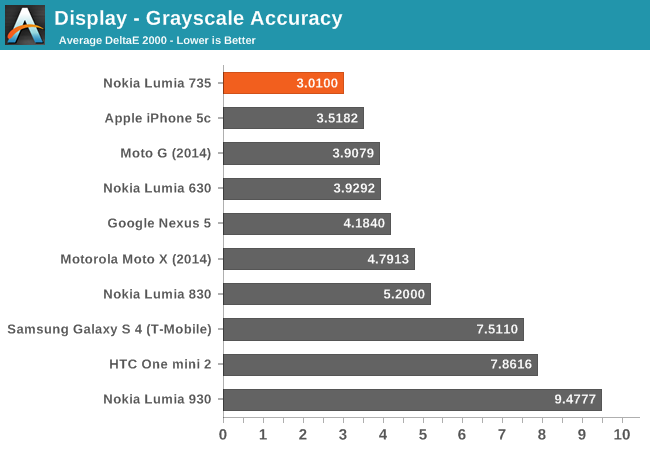
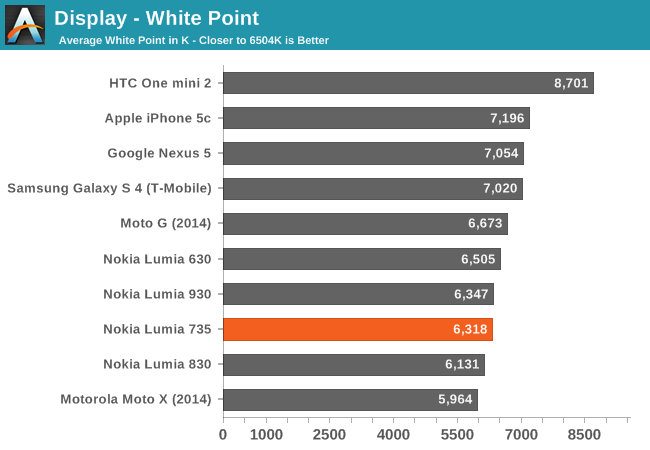

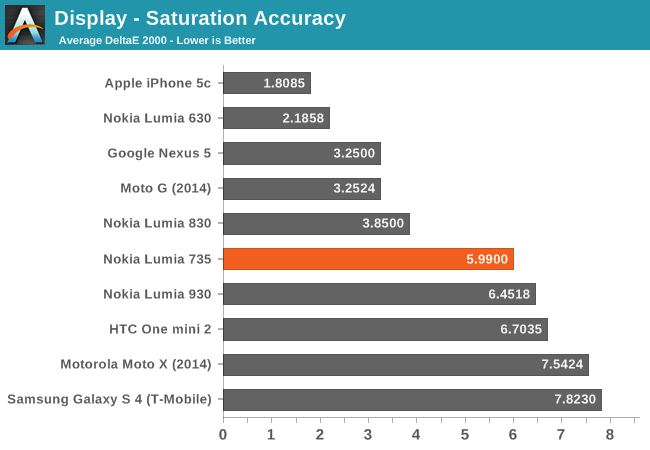

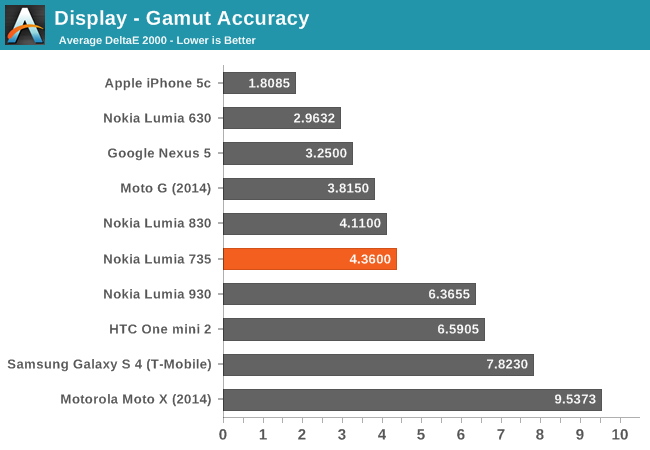

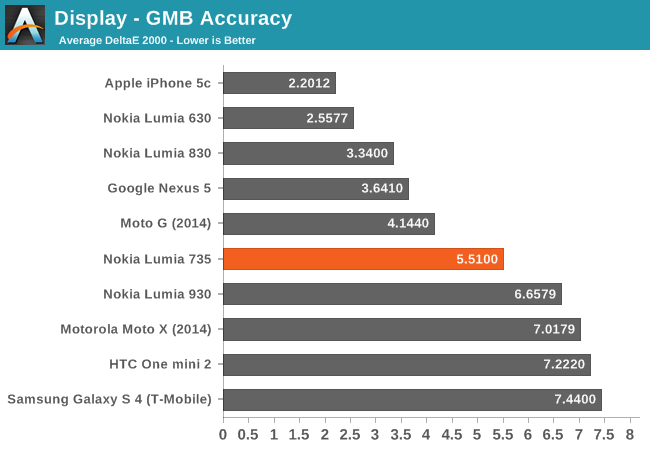








64 Comments
View All Comments
gijames1225 - Tuesday, February 3, 2015 - link
What's the rationale for when to include and when not to include iPhones in the comparisons? No iPhone was compared in the battery life charts, but it's there in a lot of the other charts.melgross - Tuesday, February 3, 2015 - link
Particularly as it was said that the testing app is now compatable across systems.Brett Howse - Tuesday, February 3, 2015 - link
We pull our data from our online database, and the iPhone would not be included if that particular test was not run on it. GFXBench just updated to this version recently on iOS (by recently I mean since our initial review)gijames1225 - Tuesday, February 3, 2015 - link
Cool, thanks for the explanation.hlovatt - Tuesday, February 3, 2015 - link
There was some comparison against iPhone5c, but inconsistent and missing for performance. So the review was a bit disappointing overall :(Brett Howse - Tuesday, February 3, 2015 - link
Our benchmarks evolve over time, and as new versions come out, we migrate towards them. The 5c was reviewed a while ago, so it would not have been run on benchmarks that came out after its launch, but price wise is still similar to the 735 so I included it where I could. If you want to compare the 735 to any other iPhones, I mentioned in the article that we have a great online tool for that called Bench which you can find a link to at the top of our main page.hlovatt - Tuesday, February 3, 2015 - link
Thanks for your reply. Pity that the newer benchmarks are not available for 5C. I guess that provided that the benchmarks don't continually change this won't be a common problem. Pity in this case, but thanks again for the reply.bullzz - Tuesday, February 3, 2015 - link
@Brett - Great review. in some CPU and GPU benchmarks why does 735 perform 10-30% slower than Moto G. I thought they were using the same socI don't know why anyone would buy this or 830 over Moto G LTE. better performance, better display, better OS. Only upside is battery life but I think MotoG has much better value to it
Daniel Egger - Tuesday, February 3, 2015 - link
Because people typically buy phones for the full package rather than just plain hardware specs? Otherwise neither Motorola nor Microsoft nor Apple would sell any phones...Brett Howse - Tuesday, February 3, 2015 - link
Yes, they are the same SoC. Snapdragon 400 in both. In the web browser tests, Internet Explorer is much slower than Chrome. IE is being replaced though, and the new replacement is already much faster, so on Windows 10, this should be less of an issue.As for the GPU benchmarks, my suspicion is that the video drivers for Adreno are more tuned for Android than they are for Windows Phone with DirectX.